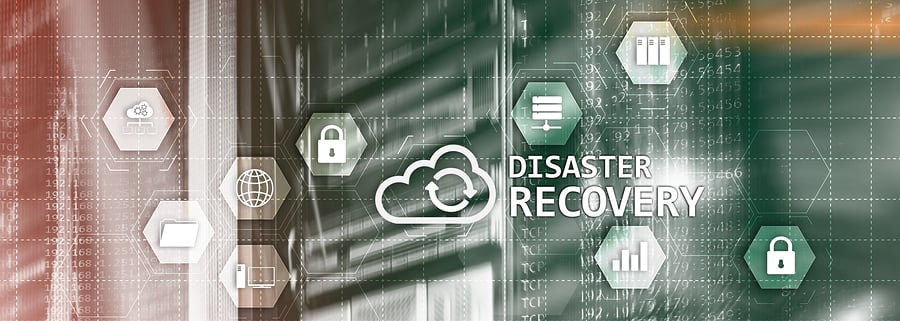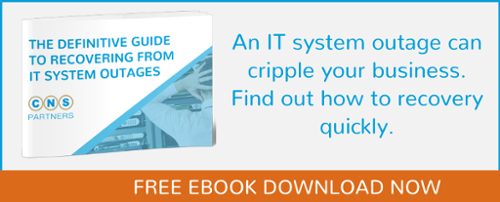
Disaster can strike any business, in any industry, at any time. Is yours ready to get back on its feet again as quickly as possible?
Whether it’s a fire, flood, extended local power outage, or major equipment failure, a disaster can be devastating to a small to midsize business. According to the Federal Emergency Management Agency (FEMA), as many as 60 percent of SMBs will never reopen their doors in the wake of a natural disaster or other adverse event. Among those that do, as many as 30% will fail within a year, especially if they’ve had to remain closed for more than five days.

Because they’re highly dependent upon uninterrupted power supplies as well as ongoing access to IT systems to run production lines, and because the continuity of their operations may be essential to other businesses both upstream and downstream in their supply chains, manufacturing businesses are particularly vulnerable to the long-term aftereffects of unplanned downtime. They may find themselves unable to fulfill contractual obligations, resulting in lasting losses of business and customer trust. And even if any physical damages to offices and plants are covered by insurance, the full costs of lost productivity—including the wages of idle employees—probably won’t be.
That’s why major enterprises spend over $6 billion per year on business continuity and disaster recovery planning, developing resilient systems, building contingency plans, and testing employee preparedness regularly. The good news is that with forethought and sound planning, even small companies can dramatically improve their own preparedness, and can do so on a shoestring budget.
Beyond backups: what is disaster recovery (DR) planning?
Disaster recovery planning involves preparing for your business’s survival in the face of catastrophic events. The planning process involves taking inventory of your systems and infrastructure, analyzing how long you could operate without access to hardware, software, and business data, and developing detailed written procedures for what you’d do in each of a variety of emergency scenarios.
Maintaining backups of your data is an essential component of DR planning, of course. But a full-fledged disaster recovery plan is far more comprehensive than simply backing up your data. Disaster recovery planning also involves people—assigning your employees or an IT partner the roles they’d need to play in a crisis—as well as technologies—such as failover capabilities, which are supplied by backup systems that could take over from the servers in your data center if they were needed.
What’s likely to be most valuable in the process of disaster recovery planning is the activity of imagining a series of “what if” scenarios. Once the unexpected has been envisioned, it’s no longer wholly unexpected. What’s more, the mere act of thinking through how you will handle difficult circumstances inherently builds resilience.
Imagine possible disaster scenarios: planning for what’s most likely
You’ll begin the DR planning process by creating a comprehensive catalog of all the IT systems—both hardware and software, on-premises and in the cloud—that your business relies on to stay up and running. Then you’ll compile a list of disaster scenarios that might occur, with a strong focus on those that are most likely.
In general, disaster scenarios can be divided into three categories:
- natural disasters. Examples of natural disasters include fires, floods, severe storms, and other weather events. Climatological data indicates that these are increasing in frequency, which means that the likelihood that your business will be impacted is greater than ever before.
- accidents and equipment failures. Recent surveys indicate that human error remains the most frequent cause of unplanned system outages, accounting for more than half of the downtime that businesses experience today. Software errors and misconfigurations, hardware failures, and simple mistakes are also a major cause.
- criminal and malicious activities. Ranging from cyberattacks to civil unrest, human-caused adverse events also contribute to a large percentage of unplanned downtime.
You can consult your insurer or an IT service provider who is knowledgeable about the risks that other businesses in your industry and geographic area face to help you determine which scenarios are most likely to impact your individual organization. Because every business is different, it’s critical to weigh your own unique risks in light of your business model to determine your priorities.
The power of the cloud: putting resilience within reach
The advent of cloud computing has been a game-changer for DR solutions. Available public and private cloud services run the gamut from simple cloud-based storage that allows you to keep backup copies of your data off-premises for an affordable price to full-fledged Business Continuity and Disaster Recovery-as-a-Service (BCDRaaS) solutions. These can provide comprehensive failover capabilities, so that you’d always have systems standing by, ready to take over from your primary servers with the flick of a switch, and may include service offerings in which the systems are configured and maintained on your behalf, as well as software for managing and restoring backups.
By turning to the cloud for DR capabilities, organizations can store their backups or build redundant systems for a tiny fraction of the cost of building secondary data centers in an additional location. This makes far more redundancy available to far more organizations at a far lower cost than would ever have been possible before.
Even the best-laid plans may fail if untested
It’s said that practice makes perfect. When it comes to restoring from backups or rehearsing a full system failover event, practice is the only thing that can guarantee that the process will work at all. Testing is an essential component of any DR plan: without it, you cannot be sure that your systems or business procedures will work as you intended them to in times of real crisis.
Whether it’s a tabletop exercise or a full simulation, it’s essential that your team go over all of the steps in various disaster scenarios at least once each year. This process can help you identify any flaws or weaknesses in your planning or make it easier to see how you’ll need to update your plans as you modernize technology systems or undergo other business changes.
Disaster recovery planning doesn’t have to be expensive or complicated. But the value it can provide your business in terms of risk reduction is nearly limitless.
Don’t wait to learn more about the process of building resilient systems. Download our latest eBook, “The Definitive Guide to Recovering from IT System Outages” today to get additional information on how to keep worst-case scenarios from harming your productivity and growth. Please consider a robust backup strategy is important to disaster recovery. If you are considering your backup strategy, consider our backup as a service offering.



